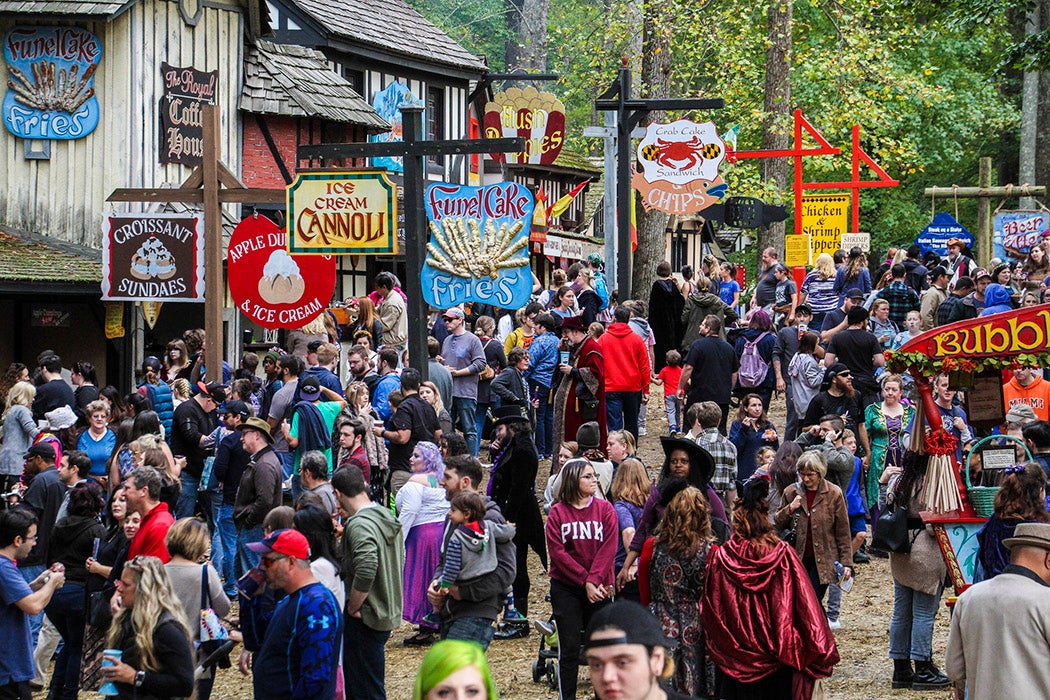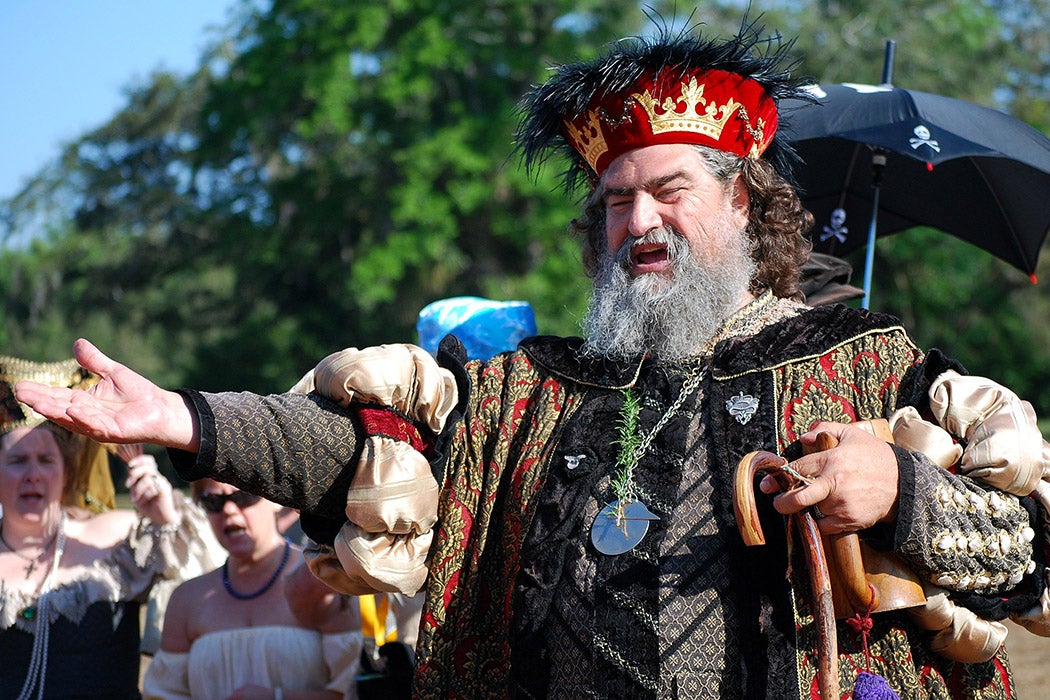With profuse apologies to George Santayana, those who cannot remember the past may be doomed to repeat it, but those who have at least some sense of recall seem to be extremely excited at the possibility of doing things all over again. Living history, in its many forms, is as popular now as it has ever been, and every Renaissance Faire or period tailor on Instagram is continuing an American vogue for acting out the past. But why re-enact the past at all?
Mass media scholar Patrick McCarthy has defined living history as “the simulation of life in another time” or any activity involving “those who appear in historical clothing and do historical work in a historical setting.” Historian Alexander Cook explains that there are two ideas typically offered to support living history. The first is that “placing modern individuals in a simulation of past situations is a useful way of making history ‘come alive’ for secular audiences.” The second is the suggestion that “participants (even professional historian participants) can learn something about history from the experience that would be less accessible using conventional methods for studying the past.”
These suppositions, and the corresponding practice of historical re-enactment for commercial, educational, and amusement purposes, go back to the nineteenth century in the United States. Nate Salsbury’s 1895 immersive “Black America” spectacle, Gilded Age Roman re-enactments, and Civil War “mock battles” are only a handful of examples of popular historical entertainments. More recently, the genre of living history has included first- and third-person interpretation, history re-staged for documentary television, immersive tourism, Renaissance Faires, and re-enactments of historic battles or pioneer living.
For the last three in particular, immersion is a primary goal. “Technically,” writes Staci Newmahr, “a Renaissance Faire is intended to feel like a sixteenth or seventeenth century English village.” The idea isn’t simply to give visitors a good time or a turkey leg, but “to make them feel as if they have been transported to another time and place.”

Renaissance Faires often involve large sprawling fairgrounds, semi-permanent or permanent vendor stalls and arena structures, and the ability to support everything from magic shows to live jousting. Similarly, American war re-enactments hope to create more than simply an assemblage of uniforms and planned logistics. Sociologist Rory Turner, looking at Civil War re-enactors, observes that the men (and yes, they are largely if not exclusively men) pay close attention to the smallest details in constructing their performative identity.
“This identity is a ‘play’ identity,” Turner writes, “but in the curious inversion of leisure culture, play identity can count more than ‘real’ identity.”
Whether strict accuracy matters or whether escapist fun is the goal of the re-enactment varies by individual as much as by pursuit. People certainly bring a range of affinities and hoped-for experiences to the table, which may revolve around fashion, politics, history, theater, fantasy fandom, community, or even just “an opportunity to go camping and get drunk with friends,” Turner writes. There’s also the unavoidably bawdy appeal, as Newmahr points out, writing that “[t]he pickle vendor is a key public character in the Renaissance Faire village [whose] primary function is to invoke the penis, in a sexual but relatively passive and humorous manner.”
Living history events create space in which there is permission to think of the past, the present, and where they connect in the mind of the individual. Immersion happens by a matter of degrees and is experienced differently by participants, spectators, vendors, and performers.
“Everything is an element of the past that never was,” writes Sam Blazer, “or, more accurately, everything is an element caught between the Past that never was and the past that never is. It happens blatantly, guilelessly, in the inner present of each spectator.”
This past isn’t only evocative and in unavoidable dialogue with the present, it’s also a business in which operators sell “the basics for looking realistic. Therefore, reenactments are moneymaking ventures, held in a nation which is based on capitalism,” writes McCarthy.
The increasing commercial and mass-media appeal of re-enactments and faires grew from manifestly scrappier roots. While living history has a long trail, most of what we recognize as modern re-enactment culture comes from the American mid-twentieth century. The original Renaissance Pleasure Faire began in southern California, in the 1960s; around the same time, the Society for Creative Anachronism, a membership-based medieval re-enactment group, was finding its feet in Berkeley. Somewhat ironically given its current mainstream appeal, the original renaissance faire was expressly countercultural, drawing on “traditions of commedia dell’arte and a local community of highly skilled but blacklisted Hollywood workers to transform a recreational theater program aimed at children into a popular costumed reenactment event for all ages,” according to Gillian Bagwell. Civil War re-enactment likewise solidified in the post-World War II years, as the last generation with living memory of the war passed on and the war’s 1960 centennial came into view. Despite countercultural origins, living history events have become widespread and commercial, so much so that in 2011, Mattel introduced Renaissance Faire Barbie.
Weekly Newsletter
Living history is also in conversation with the modern era in its omissions and limitations. A Renaissance Faire can more easily be dismissed as flexible fantasy, but war re-enactments have drawn criticism insofar as they can be “selectively presenting and interpreting the more-or-less culturally or politically perceived righteous, innocent, or emotionally safe aspects” of war, versus its horrific reality, writes scholar of human ecology and resource management James D. Bigley.
Re-enactment can also run the risk of elevating a single narrative above all others, with visitors “not made aware that there were other possibilities open to the historic figures – that, indeed, what they are seeing is just one of many possible histories,” explains theater historian Scott Magelssen. Many modern interpreters have worked to re-create fuller interpretations of American history, through more progressive mission statements (“Vintage style, not vintage values”), acknowledgments of error (as with Lost Cause mythology), and new lenses (as with interpreters including Cheyney McKnight and her approach to Black history).
Ultimately, re-enactments and fantasy spaces remain popular—perhaps even more so than ever, as performers, vendors, and visitors alike seek to escape media saturation and modern anxiety with a trip into a different, more analogue, time and place.
But then again, maybe it’s the turkey legs.
Editor’s Note: This story was updated to clarify that the Society for Creative Anachronism did not originate in southern California.







